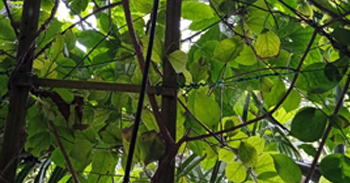KJC Medicinal Garden
Bhavamga
Celastrus paniculatus
Order: Celastrales
Family: Celastraceae
Genus: Celastrus
Species: C. paniculatus
Common Names: Common Names Jyotishmati, Black oil plant, Malkangni
Native to C. hindsii
Other plants of the same genus with medicinal properties
-
Citrus X aurantium
Citrus medica var. sarcodactylis
X citrofortunella mitis
Citrus reticulata
Citrus glauca
- Unarmed Shrub (10m tall), Reddish brown elongating slender branches (23 cm in diameter), long lenticles.
- Leaves: Simple, alternate, ovate or obovate, shortly acuminate, glabrous, base rounded or acute, petioles 6-12 mm
- Inflorescence is paniculate
- Flowers: Yellowish or greenish white, unisexual, petals 3mm
Uses in Tradition systems of medicine
- Used as brain tonic due to it’s beneficial effect on memory and intellect.
- Used in Ayurveda in treatment of vatavyadhi (Vatavyadhi includes diseases like arthritis, gout, etc.)
- seeds were found to have hypolipidemic[15] and antioxidant activity.
- flower extract is significant for it’s analgesic and anti-inflammatory activities.
- Crushed roots are used in pneumonia.
Suggested Medicinal Properties
- Anti-inflammatory
- Nootropic
- Digestive Stimulant
- Antidepressant
- Nervine Stimulant
- Carminative
- Analgesic
- Diuretic
- Aphrodisiac
- Erectogenic
- Anti-arthritic
- Antinociceptive
- Antirheumatic
- Emmenagogue
- Diaphoretic (induces perspiration)
- Thermogenic (produces heat in the body)
- Intellect promoting
- Antiproliferative (appears in breast cancer)
- Antioxidan
Active Phytochemicals
1. Alkaloids
Alkaloids like celastrine, celapanine, celapanigine, celapagine are most prominently found.
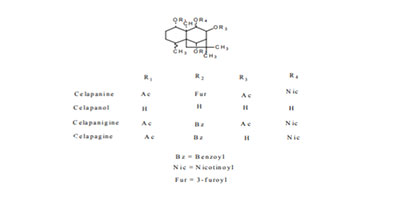
2. Polyalcohol
Malangunin, malkanginnol, malkanguniol and paniculatadiol are found.
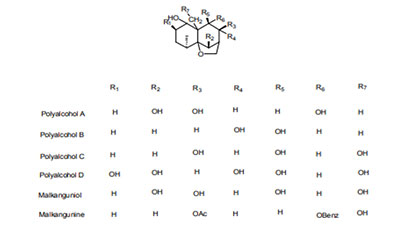
3. Triterpenoids
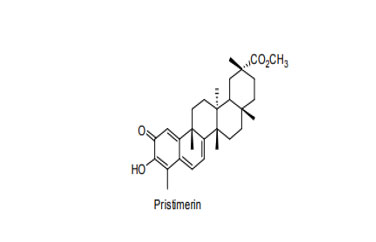
4. Sterols: β- amyrin and β-sitosterol
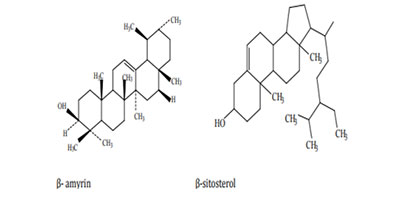
5. Sesquiterpeniod polyol esters
Two sesquiterpene polyol esters have been isolated : 1α, 8β, 14-triacetoxy-9β-furoyloxydihydro- βagarofuran, 1 α, β, 8 β,14-tetraacetoxy-9 β – benzoy-loxydihydro- β-agarofuran and 1 α,8 β – diacetoxy-9β-benzoyloxydihydro-β-agarofuran
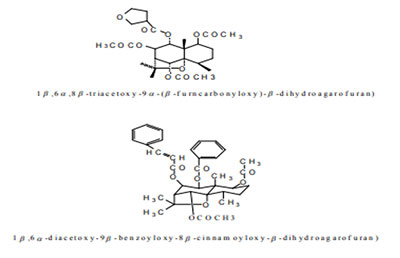
References
1) Deodhar, Ketakee & Shinde, Nanda. (2015). Full Length Review Article CELASTRUS PANICULATUS; MEDICINAL AND PHARMACOLOGICAL PROPERTIES: A REVIEW. International journal of development research. 5. 5526-5531.
2) Kulkarni, Y. A., Agarwal, S., & Garud, M. S. (2015). Effect of Jyotishmati (Celastrus paniculatus) seeds in animal models of pain and inflammation. Journal of Ayurveda and integrative medicine, 6(2), 82–88. https://doi.org/10.4103/0975-9476.146540
3) Katekhaye, Shankar & Duggal, Sanjiv & Pal, Amrit. (2011). An Inside Preview of Nutritional and Pharmacological Profile of Celastrus paniculatus. International Journal of Recent Advances in Pharmaceutical Research. 1. 19-24.
